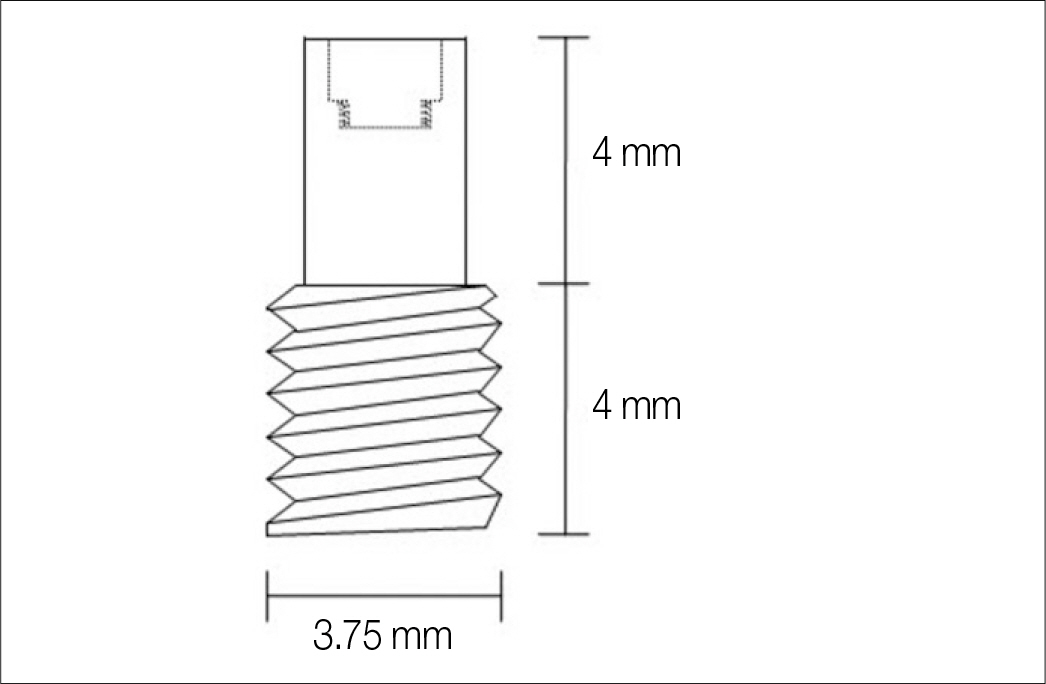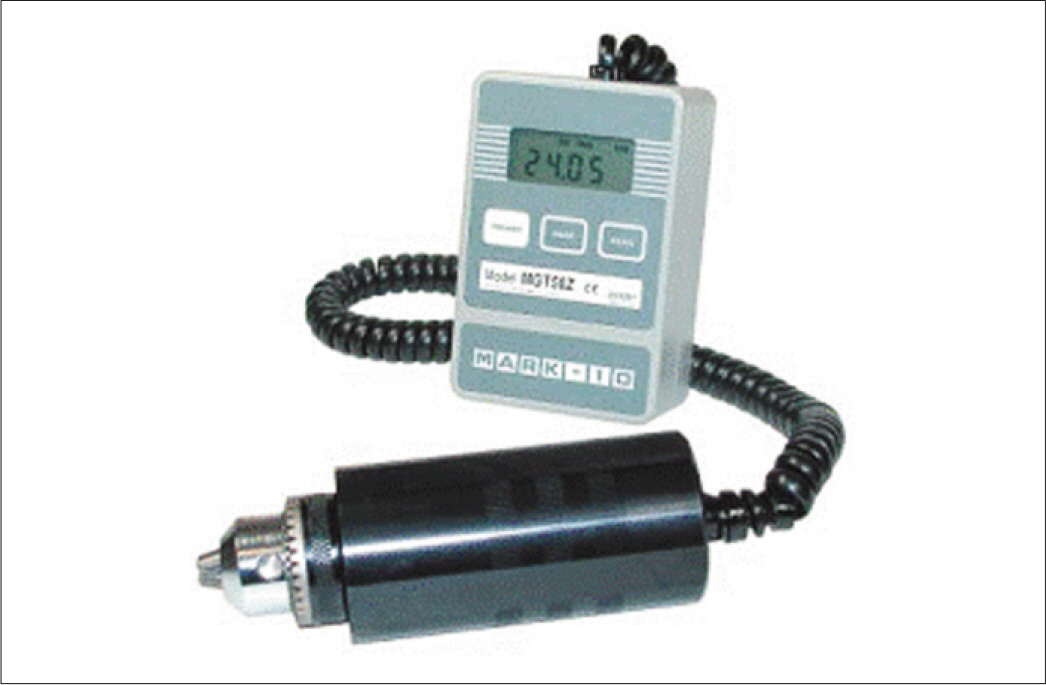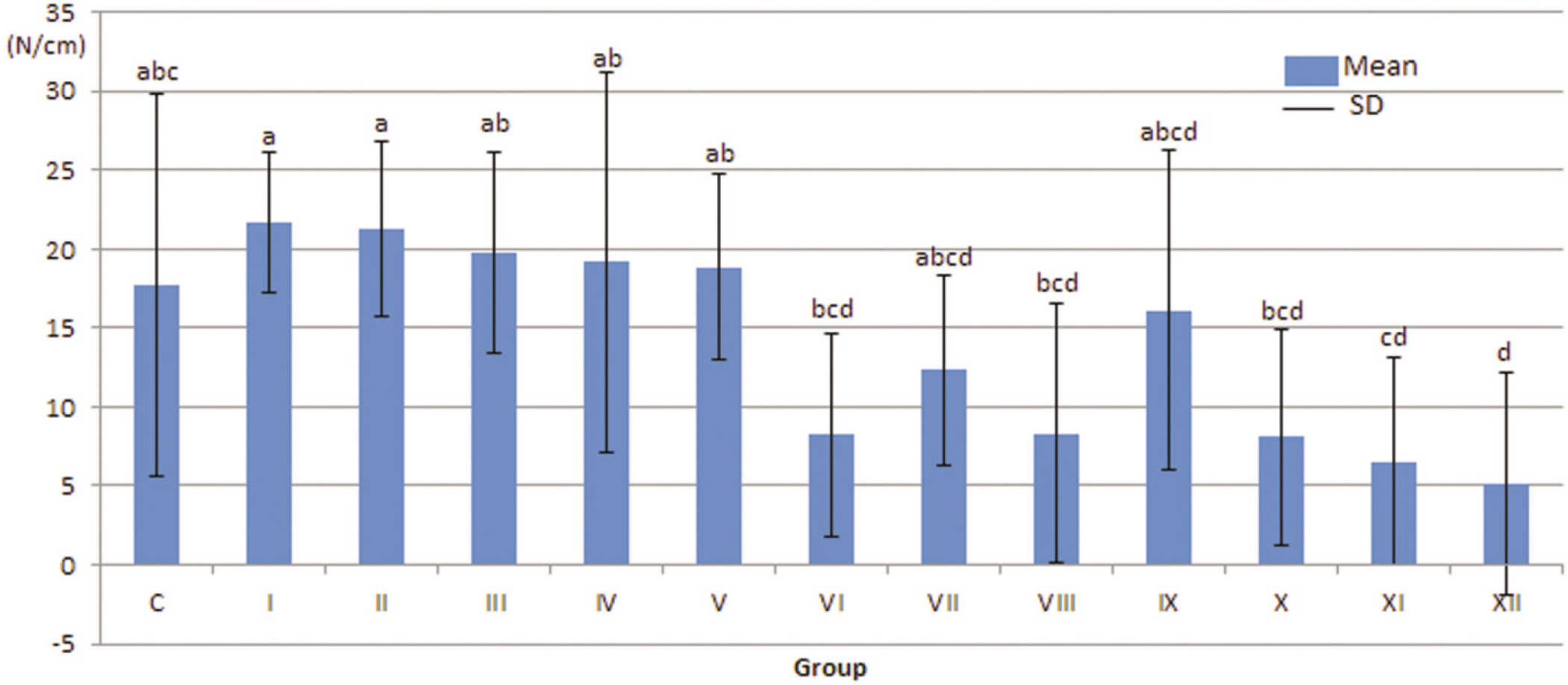J Korean Acad Prosthodont.
2014 Apr;52(2):105-112. 10.4047/jkap.2014.52.2.105.
The influence of iatrogenic mobilization in the initial stage of implant installation on final osteointegration
- Affiliations
-
- 1Department of Prosthodontics, School of Dentistry, Kyungpook National University, Daegu, Republic of Korea. chlee@knu.ac.kr
- KMID: 2000136
- DOI: http://doi.org/10.4047/jkap.2014.52.2.105
Abstract
- PURPOSE
The aim of present investigation was to find out the influence of several times iatrogenic mobilization in the initial stage of implant installation on bone-implant osteointegration.
MATERIALS AND METHODS
The experimental implants (3.75 mm in diameter, 8.0 mm in length) were made of commercially pure (Grade IV) titanium, and were treated with RBM (MegaGen(R): Ca-P) on lower 4.0 mm part. Only lower part of implant was inserted to bone and the implants were nonsubmerged. The 130 implants (two in each tibia) were inserted into the monocortical tibias of 33 rabbits which each weighed more than 3.5 kg (Female, New Zealand White). According to the removal torque interval, the groups were divided into 13 groups, group I (1 day), group II (1 day + 2 days), group III (1 day + 2 days + 3 days), group IV (1 day + 2 days + 3 days + 4 days), group V (2 days), group VI (2 days + 4 days), group VII (2 days + 4 days + 6 days), group VIII (2 days + 4 days + 6 days + 8 days), group IX (4 days), group X (4 days + 7 days), group XI (4 days + 7 days + 10 days), group XII (4 days + 7 days + 10 days + 14 days) and control group. In the control group, the removal torque was measured at 8 weeks with a digital torque gauge (Mark-10, USA). In the experimental groups, the removal torque was given once, twice, three times or four times by experiment design before the final removal torque and the value was measured each time. The implants were then screwed back to their original positions. All the experimental groups were given a final healing time of 8 weeks after placement, in which values were compared with the control groups and the 1st, 2nd, 3rd or 4th removal torque values in each experimental group.
RESULTS
In comparison of the final removal torque tests among experimental groups, the removal torque value of experimental groups except group XII were not statistically different that of control group. And the values of group I and II were significantly higher than the values of group VI, VIII, X, XI, and XII. In addition, the values of group III, IV, and V were significantly higher than group XI and XII. In comparison of the removal torque in the each experimental group, the final removal torque were significantly higher in all groups except group VIII, X, XI, and XII.
CONCLUSION
If sufficient healing time was allowed, a few mobilization of fixture at the very early stage after the implant placement in the rabbits didn't interrupt the final bone to implant osseointegration.
Keyword
MeSH Terms
Figure
Reference
-
1.Bra�nemark PI., Adell R., Breine U., Hansson BO., Lindstro¨m J., Ohlsson A. Intra-osseous anchorage of dental prostheses. I. Experimental studies. Scand J Plast Reconstr Surg. 1969. 3:81–100.2.Bra�nemark PI., Hansson BO., Adell R., Breine U., Lindstro¨m J., Halle′n O., Ohman A. Osseointegrated implants in the treatment of the edentulous jaw. Experience from a 10-year period. Scand J Plast Reconstr Surg Suppl. 1977. 16:1–132.3.Szmukler-Moncler S., Salama H., Reingewirtz Y., Dubruille JH. Timing of loading and effect of micromotion on bone-dental implant interface: review of experimental literature. J Biomed Mater Res. 1998. 43:192–203.
Article4.Akagawa Y., Hashimoto M., Kondo N., Satomi K., Takata T., Tsuru H. Initial bone-implant interfaces of submergible and supramergible endosseous single-crystal sapphire implants. J Prosthet Dent. 1986. 55:96–100.
Article5.Ivanoff CJ., Sennerby L., Lekholm U. Reintegration of mobilized titanium implants. An experimental study in rabbit tibia. Int J Oral Maxillofac Surg. 1997. 26:310–5.6.Ye SH. An investigation of reosseointegration according to time course after intentional mobilization of implant fixtures. Graduate School, Kyungpook National University. Thesis for a doctorate. 2009. 2–25.7.Jang JH., Cho JH., Lee CH. Study of the reosseointegration of implant fixture after mechanical unscrewing. J Korean Acad Prosthodont. 2010. 48:209–14.
Article8.Hwang YJ., Cho JH., Lee CH. Investigation of osseointegration according to the healing time after having iatrogenic mobility of implant fixtures. J Korean Acad Prosthodont. 2010. 48:308–14.
Article9.Cho JH. The influence of intentional mobilization of implant fixtures before osseointegration. Graduate School, Kyungpook National University. Thesis for a doctorate. 2011. 2–17.10.Szmukler-Moncler S., Piattelli A., Favero GA., Dubruille JH. Considerations preliminary to the application of early and immediate loading protocols in dental implantology. Clin Oral Implants Res. 2000. 11:12–25.
Article11.Ganeles J., Rosenberg MM., Holt RL., Reichman LH. Immediate loading of implants with fixed restorations in the completely edentulous mandible: report of 27 patients from a private practice. Int J Oral Maxillofac Implants. 2001. 16:418–26.12.Tarnow DP., Emtiaz S., Classi A. Immediate loading of threaded implants at stage 1 surgery in edentulous arches: ten consecutive case reports with 1- to 5-year data. Int J Oral Maxillofac Implants. 1997. 12:319–24.13.Piattelli A., Ruggeri A., Franchi M., Romasco N., Trisi P. An histologic and histomorphometric study of bone reactions to unloaded and loaded nonsubmerged single implants in monkeys: a pilot study. J Oral Implantol. 1993. 19:314–20.14.Schnitman PA., Wo¨hrle PS., Rubenstein JE., DaSilva JD., Wang NH. Ten-year results for Bra®nemark implants immediately loaded with fixed prostheses at implant placement. Int J Oral Maxillofac Implants. 1997. 12:495–503.15.Wismeijer D., Buser D., Belser D. ITI Treatment guide. 4th ed.Switzerland: Quintessence Publishing;2010. p. 3–8.16.Gapski R., Wang HL., Mascarenhas P., Lang NP. Critical review of immediate implant loading. Clin Oral Implants Res. 2003. 14:515–27.
Article17.Roberts WE., Smith RK., Zilberman Y., Mozsary PG., Smith RS. Osseous adaptation to continuous loading of rigid endosseous implants. Am J Orthod. 1984. 86:95–111.
Article18.Brunski JB. Avoid pitfalls of overloading and micromotion of intraosseous implants. Dent Implantol Update. 1993. 4:77–81.19.Eriksson AR., Albrektsson T. Temperature threshold levels for heat-induced bone tissue injury: a vital-microscopic study in the rabbit. J Prosthet Dent. 1983. 50:101–7.
Article20.Bra�nemark PI., Engstrand P., Ohrnell LO., Gro¨ndahl K., Nilsson P., Hagberg K., Darle C., Lekholm U. Bra®nemark Novum: a new treatment concept for rehabilitation of the edentulous mandible. Preliminary results from a prospective clinical followup study. Clin Implant Dent Relat Res. 1999. 1:2–16.21.Roberts WE., Turley PK., Brezniak N., Fielder PJ. Implants: Bone physiology and metabolism. CDA J. 1987. 15:54–61.22.Sennerby L., Thomsen P., Ericson LE. Early tissue response to titanium implants inserted in rabbit cortical bone. J Mater Science: Mater Med. 1993. 4:240–50.
Article23.Sennerby L,Thomsen P., Ericson LE. A morphometric and bio-mechanic comparison of titanium implants inserted in rabbit cortical and cancellous bone. Int J Oral Maxillofac Implants. 1992. 7:62–71.24.Sennerby L., Gottlow J. Clinical outcomes of immediate/early loading of dental implants. A literature review of recent controlled prospective clinical studies. Aust Dent J. 2008. 53:S82–8.
Article25.Misch CE. Contemporary implant dentistry. St. Louis: Mosby Elsevier;1999. p. 799–834.
- Full Text Links
- Actions
-
Cited
- CITED
-
- Close
- Share
- Similar articles
-
- Comparison of Clinical Initial Stability of Hydroxy-apatite Coated Implant and Sandblasted, Large-grit and Acid-etched Implant
- Factors Affecting Survival of Maxillary Sinus Augmented Implants
- IN VITRO COMPARATIVE STUDY BETWEEN ISQ AND PERIOTEST? VALUES ON THE IMPLANT STABILITY MEASUREMENTS ACCORDING TO THE INCREASED EFFECTIVE IMPLANT LENGTH
- Clinical outcome of immediately and early loaded implants with laser treated surface: a 3-year retrospective study
- Stability and Efficacy of Titanium in Osteointegration in a Rabbit Model





